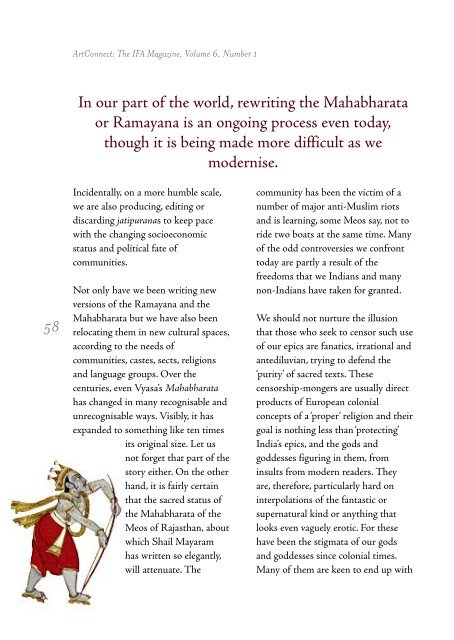Layout 3 - India Foundation for the Arts - IFA
Layout 3 - India Foundation for the Arts - IFA
Layout 3 - India Foundation for the Arts - IFA
Create successful ePaper yourself
Turn your PDF publications into a flip-book with our unique Google optimized e-Paper software.
58<br />
ArtConnect: The <strong>IFA</strong> Magazine, Volume 6, Number 1<br />
In our part of <strong>the</strong> world, rewriting <strong>the</strong> Mahabharata<br />
or Ramayana is an ongoing process even today,<br />
though it is being made more difficult as we<br />
modernise.<br />
Incidentally, on a more humble scale,<br />
we are also producing, editing or<br />
discarding jatipuranas to keep pace<br />
with <strong>the</strong> changing socioeconomic<br />
status and political fate of<br />
communities.<br />
Not only have we been writing new<br />
versions of <strong>the</strong> Ramayana and <strong>the</strong><br />
Mahabharata but we have also been<br />
relocating <strong>the</strong>m in new cultural spaces,<br />
according to <strong>the</strong> needs of<br />
communities, castes, sects, religions<br />
and language groups. Over <strong>the</strong><br />
centuries, even Vyasa’s Mahabharata<br />
has changed in many recognisable and<br />
unrecognisable ways. Visibly, it has<br />
expanded to something like ten times<br />
its original size. Let us<br />
not <strong>for</strong>get that part of <strong>the</strong><br />
story ei<strong>the</strong>r. On <strong>the</strong> o<strong>the</strong>r<br />
hand, it is fairly certain<br />
that <strong>the</strong> sacred status of<br />
<strong>the</strong> Mahabharata of <strong>the</strong><br />
Meos of Rajasthan, about<br />
which Shail Mayaram<br />
has written so elegantly,<br />
will attenuate. The<br />
community has been <strong>the</strong> victim of a<br />
number of major anti-Muslim riots<br />
and is learning, some Meos say, not to<br />
ride two boats at <strong>the</strong> same time. Many<br />
of <strong>the</strong> odd controversies we confront<br />
today are partly a result of <strong>the</strong><br />
freedoms that we <strong>India</strong>ns and many<br />
non-<strong>India</strong>ns have taken <strong>for</strong> granted.<br />
We should not nurture <strong>the</strong> illusion<br />
that those who seek to censor such use<br />
of our epics are fanatics, irrational and<br />
antediluvian, trying to defend <strong>the</strong><br />
‘purity’ of sacred texts. These<br />
censorship-mongers are usually direct<br />
products of European colonial<br />
concepts of a ‘proper’ religion and <strong>the</strong>ir<br />
goal is nothing less than ‘protecting’<br />
<strong>India</strong>’s epics, and <strong>the</strong> gods and<br />
goddesses figuring in <strong>the</strong>m, from<br />
insults from modern readers. They<br />
are, <strong>the</strong>re<strong>for</strong>e, particularly hard on<br />
interpolations of <strong>the</strong> fantastic or<br />
supernatural kind or anything that<br />
looks even vaguely erotic. For <strong>the</strong>se<br />
have been <strong>the</strong> stigmata of our gods<br />
and goddesses since colonial times.<br />
Many of <strong>the</strong>m are keen to end up with


